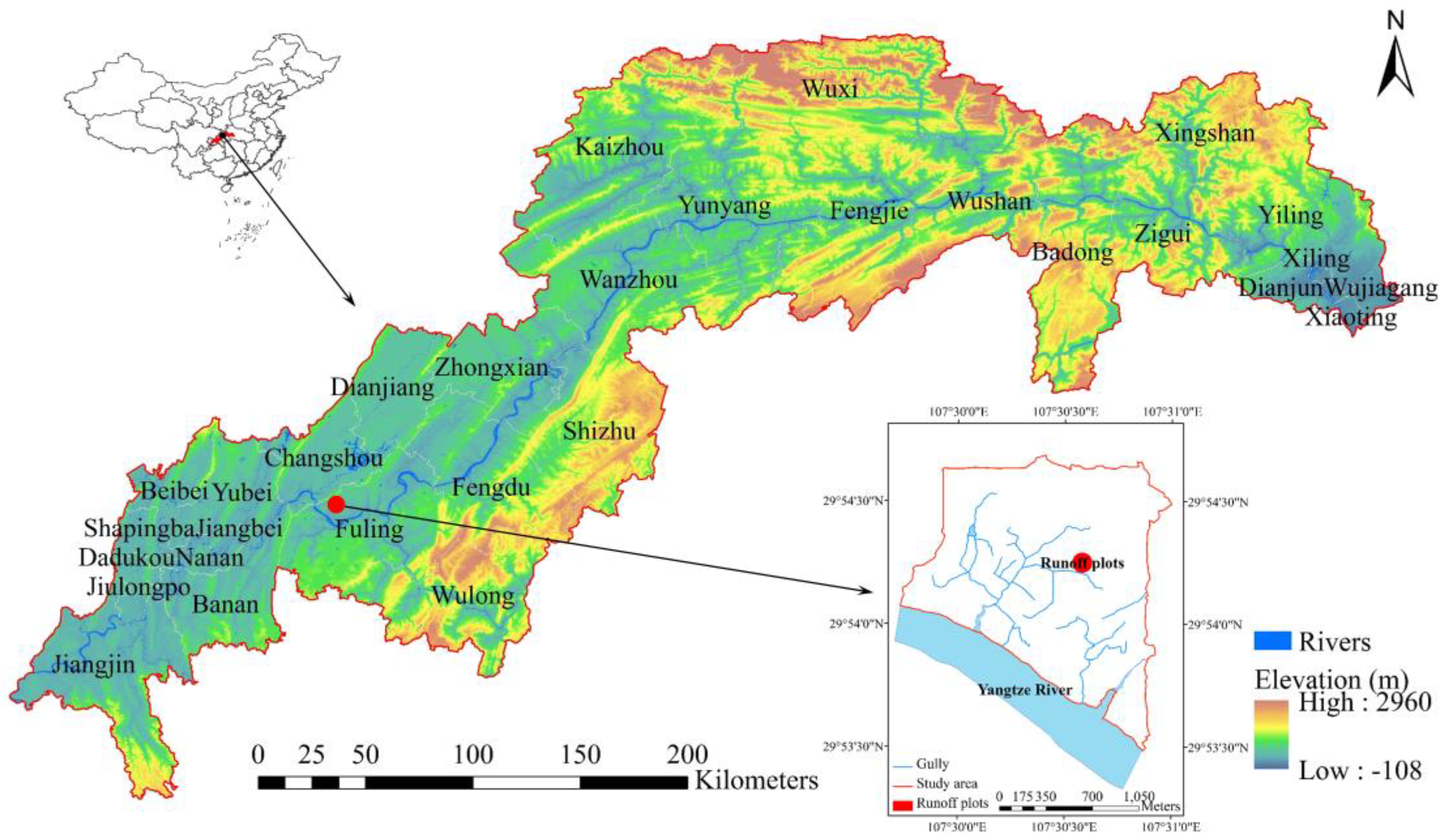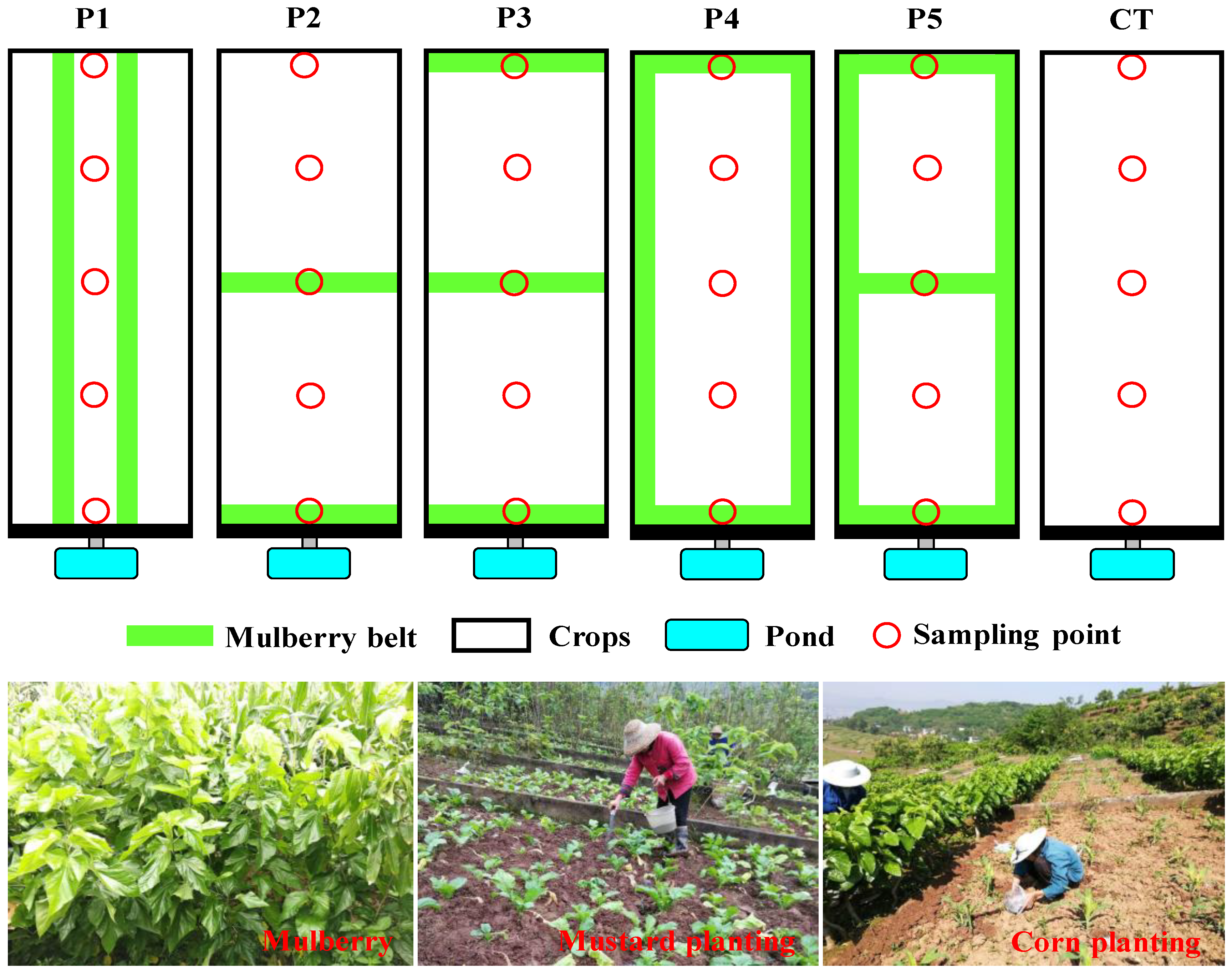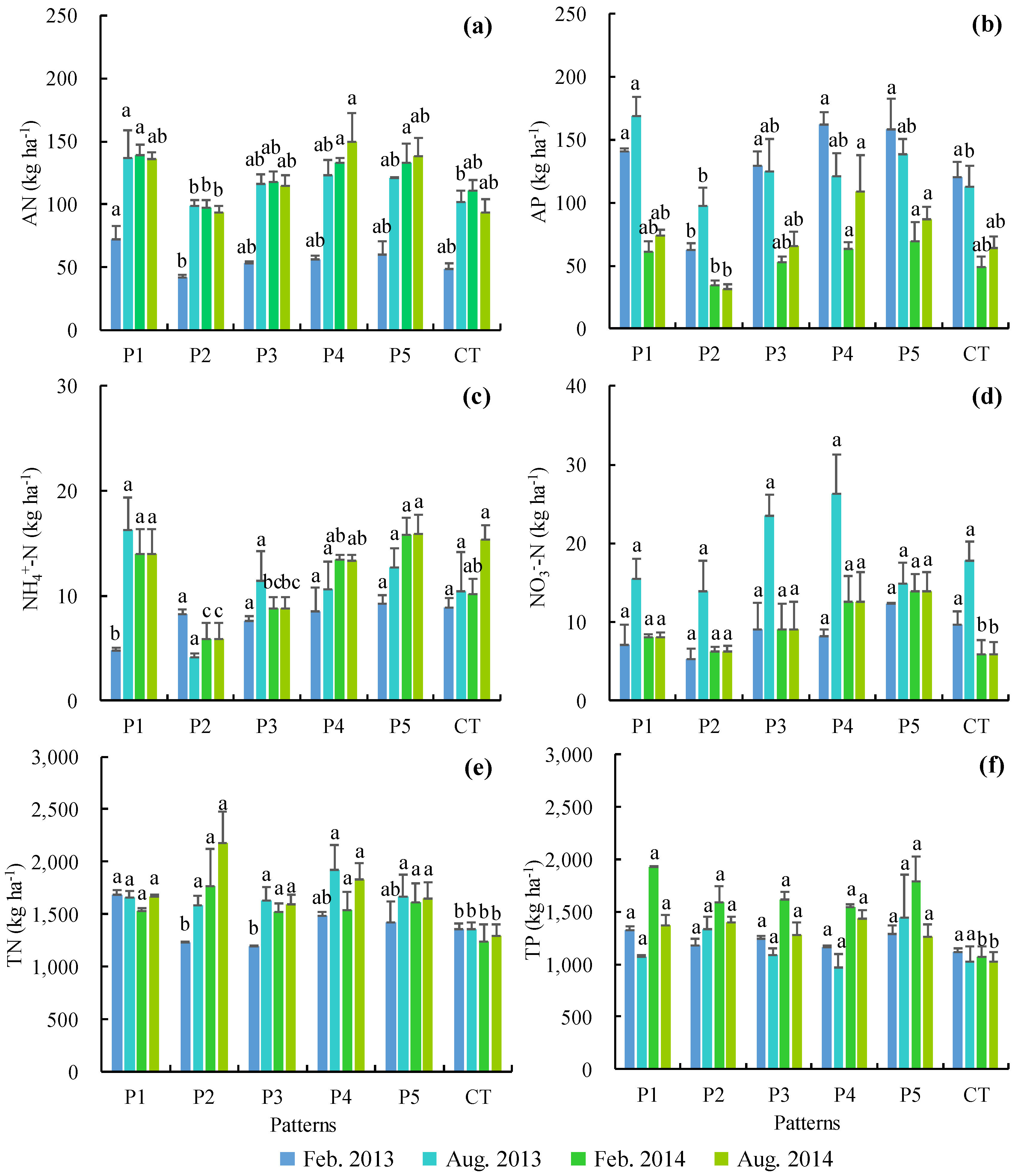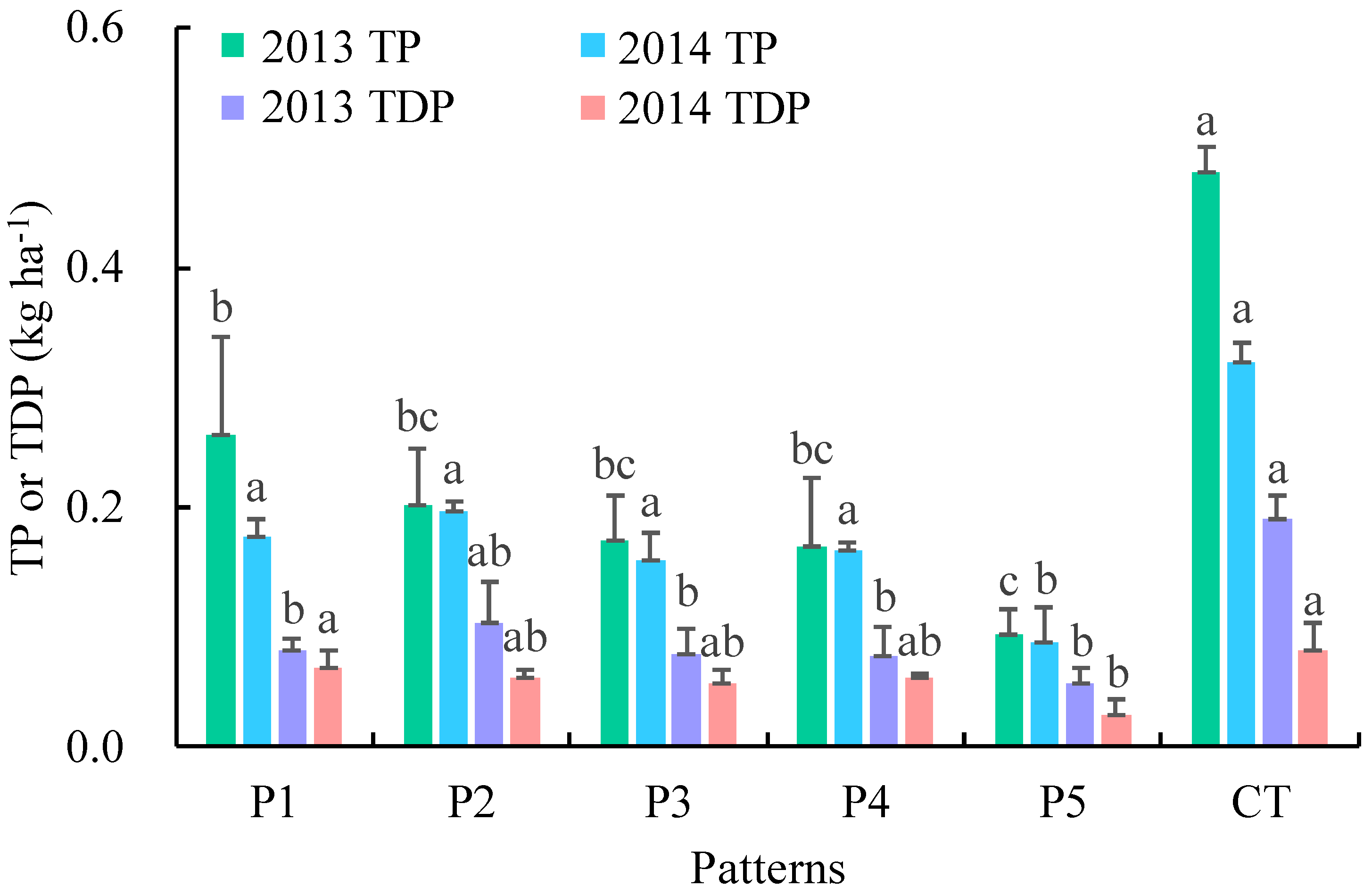Mechanized and Optimized Configuration Pattern of Crop-Mulberry Systems for Controlling Agricultural Non-Point Source Pollution on Sloping Farmland in the Three Gorges Reservoir Area, China
Abstract
:1. Introduction
2. Materials and Methods
2.1. Study Area
2.2. Experimental Design
2.3. Sampling and Testing
2.4. Data Analysis
3. Results
3.1. Effects of Crop-Mulberry Systems on Soil Aggregate Structure
3.2. Effects of Crop-Mulberry Systems on Soil Nutrient Buildup
3.3. Effects of Crop-Mulberry Systems on Water and Soil Losses
3.4. Effects of Crop-Mulberry Systems on Runoff Nutrient Loss
4. Discussion
4.1. Crop-Mulberry Systems Effectively Improve Soil Internal Structure and Increase Soil Nutrient Buildup
4.2. Crop-Mulberry Systems Effectively Control the External Loss of Soil, Water, and Nutrients
5. Conclusions
Author Contributions
Funding
Conflicts of Interest
References
- Zhang, J.; Li, S.; Dong, R.; Jiang, C.; Ni, M. Influences of land use metrics at multi-spatial scales on seasonal water quality: A case study of river systems in the Three Gorges Reservoir Area, China. J. Clean Prod. 2019, 206, 76–85. [Google Scholar] [CrossRef]
- Geng, R.Z.; Sharpley, A.N. A novel spatial optimization model for achieve the trad-offs placement of best management practices for agricultural non-point source pollution control at multi-spatial scales. J. Clean Prod. 2019, 234, 1023–1032. [Google Scholar] [CrossRef]
- Brown, T.C.; Froemke, P. Nationwide Assessment of Nonpoint Source Threats to Water Quality. Bioscience 2012, 62, 136–146. [Google Scholar] [CrossRef]
- Carpenter, S.R.; Caraco, N.F.; Correll, D.L.; Howarth, R.W.; Sharpley, A.N.; Smith, V.H. Nonpoint pollution of surface waters with phosphorus and nitrogen. Ecol. Appl. 1998, 8, 559–568. [Google Scholar] [CrossRef]
- Chen, C.; Gao, M.; Xie, D.; Ni, J. Spatial and temporal variations in non-point source losses of nitrogen and phosphorus in a small agricultural catchment in the Three Gorges Region. Environ. Monit. Assess. 2016, 188, 257. [Google Scholar] [CrossRef]
- Moges, M.A.; Tilahun, S.A.; Ayana, E.K.; Moges, M.M.; Gabye, N.; Giri, S.; Steenhuis, T.S. Non-Point Source Pollution of Dissolved Phosphorus in the Ethiopian Highlands: The Awramba Watershed Near Lake Tana. Clean-Soil Air Water 2016, 44, 703–709. [Google Scholar] [CrossRef]
- Ongley, E.D.; Zhang, X.; Yu, T. Current status of agricultural and rural non-point source Pollution assessment in China. Environ. Pollut. 2010, 158, 1159–1168. [Google Scholar] [CrossRef] [PubMed]
- Wang, T.; Zhu, B.; Xia, L. Effects of Contour Hedgerow Intercropping on Nutrient Losses from the Sloping Farmland in the Three Gorges Area, China. J. Mt. Sci. 2012, 9, 105–114. [Google Scholar] [CrossRef]
- Zhang, Y.; Fan, F.; Zhou, C.; Ni, J.; Xie, D. Effects of Crop/Mulberry Intercropping on Surface Nitrogen and Phosphorus Losses in Three Gorges Reservoir Area. Acta Pedol. Sin. 2016, 53, 189–201. [Google Scholar]
- Zhang, P.; Yan, L.; Fan, J.; Jiang, P.; Wu, Y.; Cai, L.; Xu, H.; Wang, X.; Wu, S. Effects of Different Patterns of Contour Grass Hedgerow on Soil Erosion Control. J. Ecol. Rural Environ. 2011, 27, 29–34. [Google Scholar]
- Fan, F.; Xie, D.; Wei, C.; Ni, J.; Yang, J.; Tang, Z.; Zhou, C. Reducing soil erosion and nutrient loss on sloping land under crop-mulberry management system. Environ. Sci. Pollut. Res. 2015, 22, 14067–14077. [Google Scholar] [CrossRef] [PubMed]
- Pavlidis, G.; Tsihrintzis, V.A. Environmental Benefits and Control of Pollution to Surface Water and Groundwater by Agroforestry Systems: A Review. Water Resour. Manag. 2018, 32, 1–29. [Google Scholar] [CrossRef]
- Torralba, M.; Fagerholm, N.; Burgess, P.J.; Moreno, G.; Plieninger, T. Do European agroforestry systems enhance biodiversity and ecosystem services? A meta-analysis. Agric. Ecosyst. Environ. 2016, 230, 150–161. [Google Scholar] [CrossRef] [Green Version]
- Marais, Z.E.; Baker, T.P.; O’Grady, A.P.; England, J.R.; Tinch, D.; Hunt, M.A. A Natural Capital Approach to Agroforestry Decision-Making at the Farm Scale. Forests 2019, 10, 980. [Google Scholar] [CrossRef] [Green Version]
- Lovell, S.T.; Dupraz, C.; Gold, M.; Jose, S.; Revord, R.; Stanek, E.; Wolz, K.J. Temperate agroforestry research: Considering multifunctional woody polycultures and the design of long-term field trials. Agrofor. Syst. 2018, 92, 1397–1415. [Google Scholar] [CrossRef]
- Shrestha, B.M.; Chang, S.X.; Bork, E.W.; Carlyle, C.N. Enrichment Planting and Soil Amendments Enhance Carbon Sequestration and Reduce Greenhouse Gas Emissions in Agroforestry Systems: A Review. Forests 2018, 9, 369. [Google Scholar] [CrossRef] [Green Version]
- IUSS Working Group WRB. World Reference Base for Soil Resources 2014, update 2015 International Soil Classification System for Naming Soils and Creating Legends for Soil Maps; World Soil Resources Reports No. 106; IUSS Working Group WRB: Rome, Italy, 2015. [Google Scholar]
- Nyssen, J.; Poesen, J.; Moeyersons, J.; Lavrysen, E.; Haile, M.; Deckers, J. Spatial distribution of rock fragments in cultivated soils in northern Ethiopia as affected by lateral and vertical displacement processes. Geomorphology 2002, 43, 1–16. [Google Scholar] [CrossRef]
- Lal, R.; Shukla, M.K. Principles of Soil Physics; Marcel Dekker, Inc.: New York, NY, USA, 2004. [Google Scholar]
- Dane, J.H.; Topp, G.C. Methods of Soil Analysis, Part 4. Physical Methods; Soil Science Society of America: Madison, WI, USA, 2002. [Google Scholar]
- Sparks, D.L.; Page, A.L.; Helmke, P.A.; Loeppert, R.H.; Soltanpour, P.N.; Tabatabai, M.A.; Johnston, C.T.; Sumner, M.E. Methods of Soil Analysis, Part 3: Chemical Methods; Soil Science Society of America, Inc.: Madison, WI, USA, 1996. [Google Scholar]
- Khan, S.; Mulvaney, R.L.; Hoeft, R. A simple soil test for detecting sites that are nonresponsive to nitrogen fertilization. Soil Sci. Soc. Am. J. 2001, 65, 1751–1760. [Google Scholar] [CrossRef]
- Black, C.A. Methods of Soil Analysis, Part 2: Chemical and Microbiological Properties; American Society of Agronomy, Inc.: Madison, WI, USA, 1965. [Google Scholar]
- Olsen, S.R.; Cole, C.V.; Watanabe, F.S.; Dean, L.A. Estimation of Available Phosphorus in Soils by Extraction with Sodium Bicarbonate. USDA Circular No. 939; US Department of Agriculture: Washington, DC, USA, 1954.
- Du, J. Pedogenetic Features of Soils in the Purple Hilly Area of the Sichuan Basin. Ph.D. Thesis, Southwest University, Chongqing, China, 2014. [Google Scholar]
- Amezketa, E. Soil aggregate stability: A review. J. Sustain. Agric. 1999, 14, 83–151. [Google Scholar] [CrossRef]
- Lal, R. Soils and Sustainable Agriculture: A Review. In Sustainable Agriculture; Lichtfouse, E., Navarrete, M., Debaeke, P., Souchere, V., Alberola, C., Eds.; Springer: Berlin/Heidelberg, Germany, 2009. [Google Scholar]
- Hu, F.; Liu, J.; Xu, C.; Wang, Z.; Liu, G.; Li, H.; Zhao, S. Soil internal forces initiate aggregate breakdown and splash erosion. Geoderma 2018, 320, 43–51. [Google Scholar] [CrossRef]
- Bandyopadhyay, K.K.; Lal, R. Effect of land use management on greenhouse gas emissions from water stable aggregates. Geoderma 2014, 232, 363–372. [Google Scholar] [CrossRef]
- Yang, S.; Jansen, B.; Absalah, S.; van Hall, R.L.; Kalbitz, K.; Cammeraat, E.L.H. Lithology- and climate-controlled soil aggregate-size distribution and organic carbon stability in the Peruvian Andes. Soil 2020, 6, 1–15. [Google Scholar] [CrossRef] [Green Version]
- Cambardella, C.A.; Elliott, E.T. Particulate Soil Organic-Matter Changes across a Grassland Cultivation Sequence. Soil Sci. Soc. Am. J. 1992, 56, 777–783. [Google Scholar] [CrossRef]
- Gale, W.J.; Cambardella, C.A.; Bailey, T.B. Root-derived carbon and the formation and stabilization of aggregates. Soil Sci. Soc. Am. J. 2000, 64, 201–207. [Google Scholar] [CrossRef]
- Tisdall, J.M.; Oades, J.M. Organic matter and water-stable aggregates in soils. J. Soil Sci. 1982, 33, 141–163. [Google Scholar] [CrossRef]
- Yuan, J.; Peng, S.; Jiang, X.; Xie, D. Effects of combing ridge and no-tillage on aggregates and organic matter in a rice-based cropping system. Trans. CSAE 2010, 26, 153–160. [Google Scholar]
- Hu, F.; Xu, C.; Li, H.; Li, S.; Yu, Z.; Li, Y.; He, X. Particles interaction forces and their effects on soil aggregates breakdown. Soil Tillage Res. 2015, 147, 1–9. [Google Scholar] [CrossRef]
- Zhu, B.; Wang, Z.; Wang, T.; Dong, Z. Non-Point-Source Nitrogen and Phosphorus Loadings from a Small Watershed in the Three Gorges Reservoir Area. J. Mt. Sci. 2012, 9, 10–15. [Google Scholar] [CrossRef]
- Zhang, Q.; Chen, S.; Dong, Y.; Liu, D.; Yang, X.; Yang, Z. Controllability of phosphorus losses in surface runoff from sloping farmland treated by agricultural practices. Land Degrad. Dev. 2017, 28, 1704–1716. [Google Scholar] [CrossRef]
- Pu, Y.; Xie, D.; Ni, J.; Wei, C. Evaluation on comprehensive ecological benefits of different hedgerow patterns on slope-farmland in purple soil area. Chin. J. Eco-Agric. 2014, 22, 44–51. [Google Scholar]
- Adhikary, P.P.; Hombegowda, H.C.; Barman, D.; Jakhar, P.; Madhu, M. Soil erosion control and carbon sequestration in shifting cultivated degraded highlands of eastern India: Performance of two contour hedgerow systems. Agrofor. Syst. 2017, 91, 757–771. [Google Scholar] [CrossRef]
- Dercon, G.; Deckers, J.; Poesen, J.; Govers, G.; Sanchez, H.; Ramirez, M.; Vanegas, R.; Tacuri, E.; Loaiza, G. Spatial variability in crop response under contour hedgerow systems in the Andes region of Ecuador. Soil Tillage Res. 2006, 86, 15–26. [Google Scholar] [CrossRef]
- Sun, H.; Tang, Y.; Xie, J. Contour hedgerow intercropping in the mountains of China: A review. Agrofor. Syst. 2008, 73, 65–76. [Google Scholar] [CrossRef]
- Xia, L.; Hoermann, G.; Ma, L.; Yang, L. Reducing nitrogen and phosphorus losses from arable slope land with contour hedgerows and perennial alfalfa mulching in Three Gorges Area, China. Catena 2013, 110, 86–94. [Google Scholar] [CrossRef]







| Variable | Equation | R² |
|---|---|---|
| Sediment | y1 = 0.0012r − 0.0869 | 0.7957 |
| NH4+–N | y2 = 0.0001r + 0.0783 | 0.1735 |
| NO3−–N | y3 = 0.0007r − 0.0116 | 0.9232 |
| TN | y4 = 0.0051r + 0.0124 | 0.9651 |
| PN | y5 = 0.0042r − 0.0592 | 0.9062 |
| TP | y6 = 0.0007r + 0.0578 | 0.6031 |
| TDP | y7 = 0.0002r + 0.028 | 0.7045 |
© 2020 by the authors. Licensee MDPI, Basel, Switzerland. This article is an open access article distributed under the terms and conditions of the Creative Commons Attribution (CC BY) license (http://creativecommons.org/licenses/by/4.0/).
Share and Cite
Zhong, S.; Han, Z.; Li, J.; Xie, D.; Yang, Q.; Ni, J. Mechanized and Optimized Configuration Pattern of Crop-Mulberry Systems for Controlling Agricultural Non-Point Source Pollution on Sloping Farmland in the Three Gorges Reservoir Area, China. Int. J. Environ. Res. Public Health 2020, 17, 3599. https://0-doi-org.brum.beds.ac.uk/10.3390/ijerph17103599
Zhong S, Han Z, Li J, Xie D, Yang Q, Ni J. Mechanized and Optimized Configuration Pattern of Crop-Mulberry Systems for Controlling Agricultural Non-Point Source Pollution on Sloping Farmland in the Three Gorges Reservoir Area, China. International Journal of Environmental Research and Public Health. 2020; 17(10):3599. https://0-doi-org.brum.beds.ac.uk/10.3390/ijerph17103599
Chicago/Turabian StyleZhong, Shouqin, Zhen Han, Jiangwen Li, Deti Xie, Qingyuan Yang, and Jiupai Ni. 2020. "Mechanized and Optimized Configuration Pattern of Crop-Mulberry Systems for Controlling Agricultural Non-Point Source Pollution on Sloping Farmland in the Three Gorges Reservoir Area, China" International Journal of Environmental Research and Public Health 17, no. 10: 3599. https://0-doi-org.brum.beds.ac.uk/10.3390/ijerph17103599





